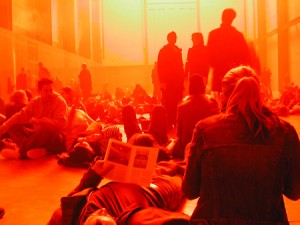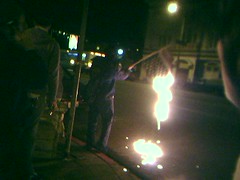Two winters ago, I traveled to London for work. It was cold as hell, as a witch's tit, as the blood that runs in Dwyane Wade's veins during the fourth quarter. The sky was deep gray, hard, heavy and forbidding, and it felt as if it wasn't more than 10 or 12 feet above my head, ready to come crashing down at any moment. One afternoon, in a jet-lagged haze, I wandered over to the Tate Modern, where it seems they always have some thought-provoking installation (for instance, Anish Kapoor's gigantic levitating horn which blew my mind for a while), and as I descended the ramp into the museum, I was struck by the absolute inversion of wintry, outdoor London. I took lots of photos, but none could really communicate the immersive aspect of Olafur Eliasson's work, called "The Weather Project." It was all reds and oranges, all warmth and mist, enveloping you in a happy, gauzy glow. Cynthia Zarin recently profiled Eliasson for the New Yorker, and she comments that the Weather Project cemented Eliasson's reputation in the art world … (Unfortunately, I can't find a link to the article online, but by all means dig through back issues of the magazine at the laundromat, if you get a chance. The article provides interesting insight into Eliasson's process, and includes some funny anecdotes relating to his impulse to immerse the viewer in an environment. For instance, in mid-long-distance-phone-conversation with Cynthia Zarin, he places his cell phone on the luggage conveyer belt at the airport, lets it go around the carousel once, then picks it up and asks her what the experience was like. Hmm.).
Category: reviews
Items in which I deliver my opinion of an event, work of art, destination, cuisine, ethnicity, etc.
I was just watching ESPN's Opening Day coverage of the Braves-Dodgers game, and the conversation between commentator Erik Karros (wasn't he Rookie of the Year like 5 years ago?) and Rick Sutcliffe turned to steroids. Karros couldn't contain himself. He blustered and rambled for a while, criticizing those who demanded an investigation, and basically rehashed Mark McGwire's non-denial denial to a Senate sub-committee: Steroids were abused in the past; the league has adopted a stricter policy; let's all move on. The message was unoriginal — a lot of current players don't want to dwell on this unsavory development — but the air of defensiveness mixed with disdain seemed oddly reminscent of another guilty, defiant person — Donald Rumsfeld.Anyway, over the past couple of days, I tore through Game of Shadows, the recently published steroids expose by Mark Fainaru-Wada and Lance Williams. After a month of PR build-up and published excerpts, there weren't many surprises:
- Bonds availed himself of steroids. One might say, a buttload of steroids.
- So did Marion Jones.
- They're both liars.
- So are a lot of professional athletes.
Bonds is the big story in Game of Shadows. If you couldn't already tell by his cartoonishly swollen neck/head and his late-career power explosion, Bonds hasn't been playing fair. He admitted to a grand jury that he allowed his trainer (a known juicer) to place droplets of an "unknown" chemical under his tongue, and to rub an "unknown" cream on his joints. Bonds thought that these were legal supplements — the drops were "flaxseed oil" — yeah, he actually said that — and he implied that he'd never injected anything. Uh-huh, yeah. I'm a fan of the flaxseed oil, and I can testify that it doesn't make your head become like 5x bigger. Plus, Bonds has always been a control freak. Is it even remotely possible that he didn't bother finding out what his trainer was sticking in his mouth?The book reveals the Bonds was on a steroid regimen that included more than "flaxseed oil," making it seem even more likely that Bonds perjured himself in front of the grand jury. Sources close to him indicate that he was on all sorts of injectable crap, including Decadurabolin (in the butt) and human growth hormone (in the stomach). He wanted us to believe that it was all free weights and sprints and vitamins, but it makes a little more sense that there was some secret sauce in the mix.A personal note: Barry, dude, seriously. Just freakin admit it. You're like a little kid sitting in a pile of cookie crumbs, crying and claiming that you didn't eat any cookies. It's undignified, really. Say "I took steroids because I wanted to win, because everyone else was, because it's what I had to do." Fans understand competitiveness, and you're a competitive guy, and steroids weren't against the rules anyway. So just fess up, you big baby. At some point, you could even ask for our forgiveness. I mean, it's possible. You always claim that you're not given the respect you deserve. Here's your chance to earn it.
Of course Crash won Best Picture. Why wouldn't Academy members — I'm assuming they're mostly white and Angeleno — rally around a film that momentarily relieved them of guilt they feel for living in such a racially segregated city? (I have to admit that I love Ludacris's rant about the racial implications of riding city buses. That, and Don Cheadle's opening, were the only moments in the entire movie that weren't heavy-handed, cheesy, or gag-inducing).The Morning News has a great list of quotes from other reviewers who disliked the movie as much as I did. A sample: "Contrived, obvious and overstated, Crash is basically just one white man's righteous attempt to make other white people feel as if they've confronted the problem of racism head-on."
First Thursdays at 49 Geary can be overwhelming, people-wise, and underwhelming, art-wise, and this month was different only in that the overwhelmingness was crammed into one place: the Fraenkel Gallery. Packed with people, it also displayed a face-melting collection of Richard Misrach photos.
When I first saw Misrach's photos, I thought immediately of Sebastiao Salgado. Both guys address big themes — civilizations, seasons, landscapes, human endeavors — but they do so in vastly different ways. Salgado frames his work around human action; his subjects are migrants, activitists, laborers. Misrach works with earth, light, space; he works with dunes, strangers, cars, power plants. Salgado's work is tied to current events, political movements, regimes, definable moments and recognizable things; Misrach works with more anonymous objects and landscapes. There are much more significant differences between them, but they share a social awareness that invests the best of their work with real intrigue and importance.
Last night we checked out the Oakland Art Murmur. Actually, we didn't even know that such a thing existed, and drove over the Bridge intending to see Jason Munn's opening at Bloom Screen Printing. So it was a pleasant surprise to see that little stretch of Telegraph goin off when we got there. Jason's stuff was the best of the art stuff, by far, but the action on the street was out front of Rock Paper Scissors.That's where we saw a guy burn an American flag. It took him roughly 10 minutes of false starts to light it with a Bic, but just after I took this picture, an ambulance raced up the street, sirens blaring, on its way to some emergency, but it abruptly slowed down when the driver saw the burning flag, and we could see the faces of the other paramedics staring at the guy as they crawled by. It was one of those only-in-Oakland moments. Holla!
Music / Konono #1 lights it up
Last night, Konono #1 played the Palace of Fine Arts. Before the show, I was a little worried that their scruffy, off-kilter sound may get washed-out by the fancy sound-system of the PoFA, and that they may end up sounding like lame-ass Ashkenaz-style "world music."But from the first moment, they totally ruled, and their signature sound — with homemade electric pick-ups for their ikembes (thumb pianos), dented metal discs serving as cymbals, and MASH-style megaphones as a PA — was faithfully recreated. The PoFA is a chamber-music-style venue with cushy seats and little room to boogie, but most of the crowd was standing and dancing by the third song, and groups crowded at the sides of the stage to improvise a little dance floor. Their final song was an epic, 45-minutes trance-inducing jam that had everyone clapping and chanting along with the track-suit-clad front man.Most remarkable was the vitality of it all, the sense that there was something essential and healthy and real being created. Each band member's intense, insistent presence was spell-binding, especially the older guy in the blue baseball hat who traded off with Mingiedi (the leader, pictured) on the thumb piano and percussion. He was locked into a serious groove the whole night, banging out precise rhythms, and belting out crisp, deep monotone harmonies that were jarring but somehow perfect. It's not often that San Francisco crowds get up and shake their asses, so it was especially impressive that Konono #1 made dancing in a concert hall on Sunday night seem totally natural.
Burgers in SF
After a chill afternoon at China Beach, we checked out some burgers at Bill's Place, which made me think about all of the good burgers to be found in San Francisco:
- Bill's Place (pictured) grinds its own, and names its burger platters after local celebrities. Extra credit for the chandeliers and non-mayo cole slaw. On the downside, it's unjustifiably pricey. $10 for a burger? Maybe at Zuni, but it seems weird to pay this much at a diner.
- If you're interested in diner-style ambiance more than good-tasting burgers, you can check out Joe's Cable Car. I really wish that the burgers tasted good there, but the reality is that they don't.
- For fake retro ambiance, high tourist quotient and really mediocre burgers, Mel's is your place. There are at least three very unconvenient Mel's locations, if you're Mission/Lower-Haight based.
- Slow Club has (or used to have) a good yuppie burger — sprouts and fancy aioli, on some kind of Euro roll. Being from the Midwest, I dislike froofy interpretations of burgers, but in weaker moments I have been known to order this burger. And enjoy it.
- Speaking of froofy, Zuni serves a burger amidst its generally tasty Cali cuisine. In 1996-ish, I could not bring myself to admit that it was good; in 2005, I can.
- On cold nights, Zeitgeist can ring your chimes with a good char-burger. On warm, busy nights, expect extra char.
- BurgerMeister and Burger Joint are all about happy cows (Niman Ranch beef), sterile, fluorescent-lit dining rooms (creepy) and, in the end, similar burgers. Hipsters split hairs about which is better. I call it a tie. (But the Meiser has Mitchell's ice cream.)
- I'm a recent convert to the virtues of Big Mouth in the Mission. Quality control is in full effect on both fries and burgers, plus greasy-spoon atmosphere distinguishes it from the sterile environs of the BJs and BMs of the world.
- Everyone talks about Barney's Gourmet Hamburgers but I personally don't see what the fuss is about. It's not that I dislike white people, but it annoys me that the owners avoid all but the whitest of white neighborhoods — North Berkeley, North Oakland, Noe Valley. Dude, next stop: Mill Valley.
There are lots more. I'll update soon.
After Hurricane Katrina, the recent Harper's magazine feature about the uncontrollable, unfathomed termite infestation of the French Quarter seems downright eerie. Equal parts information and meditation, Duncan Murrell's "The Swarm" is an effective, moving blend of first-hand reporting on blizzard-like termite swarms, spooky interviews with insect experts, and genuine Southern gothic moments:
Where the Formosans are foraging — in the studs of a wall, for instance — the carton sometimes takes the shape of the very thing they're eating. Pest-control operators in New Orleans told me many of stories of ripping out drywall to expose what looked from a distance like solid two-by-four framing pieces, only to find that they were looking at carton nests, the ghosts of a wall long since consumed.
It also provides a peek into the world of the termitologist, touching on the tragic tale of a manic-depressive South African entomologist who became so obsessed with termites that he began to view their behavior in perhaps overly sophisticated terms:
[Eugene] Marais believed that colonies of termites were distinct, compound organisms not unlike the human body, that every component from queen to worker served a function not just analogous but identical to the function of our own hearts and livers and brains and blood cells. Marais thought that the termite colony lacked only the power to move together as one organism, and that someday they would develop even that skill.
Next on my reading list: Marais's "classic work of obsessive observation," The Soul of the White Ant.
Has there been a more thankless task in modern literary history than editing Hunter S. Thompson? According to former Rolling Stone editor Robert Love, the magazine actually assigned junior editors the task of babysitting Thompson as he approached his deadline. (Okay, there are worse junior editing tasks than that; I've done them). In a recent in the Columbia Journalism Review article, Love discusses this and much more in his essay about editing the good doctor at Rolling Stone. Charming revelation: HST's bluster and bombast attained readability only after long, hard editorial oversight. The kind of oversight that involves tearing the thing apart and and reassembling it sentence by sentence:
So, a flurry of manuscript pages would arrive, buzzing with brilliant, but often disconnected passages, interspersed with what Hunter would himself call "gibberish" (on certain days) and previously rejected material, just to see if we were awake. "Stand back," the first line would inevitably say, announcing the arrival of twenty-three or twenty-five or forty pages to follow in the fax machine. Soon there were phone calls from Deborah Fuller or Shelby Sadler or Nicole Meyer or another of his stalwart assistants. We always spoke of "pages," as in "How many pages will we get tonight?" "We need more pages than that." "Can you get those pages marked up and back to Hunter?" Pages were the coin of the realm; moving pages was our mission. I would mark them up, make copies for Jann, and then send them back.
The issue for the magazine was never that Hunter wasn't the funniest, cleverest, most hilarious writer, sentence to sentence or paragraph to paragraph. The editor's role was getting those sentences to pile up and then exhibit forward momentum. (Hunter called this process "lashing them together.")






